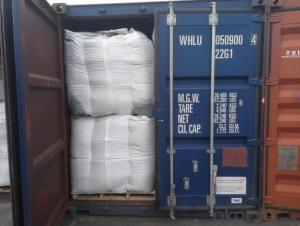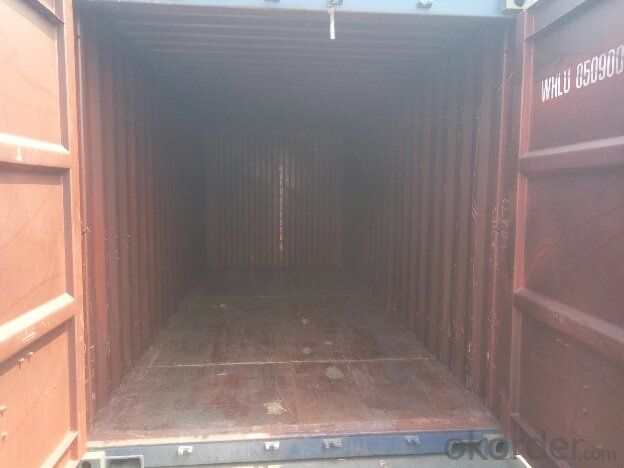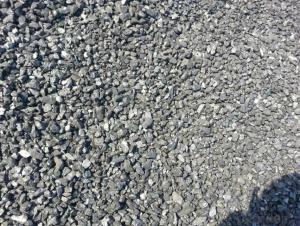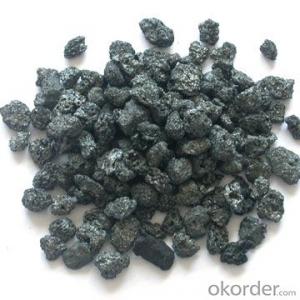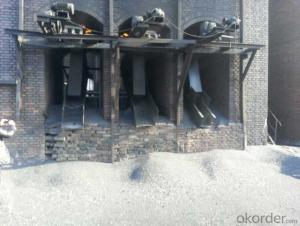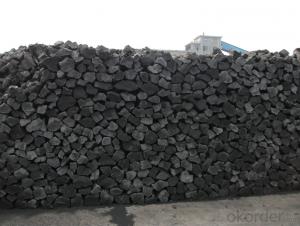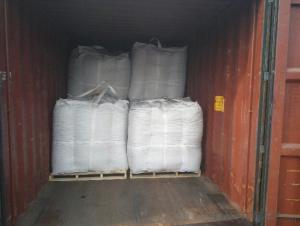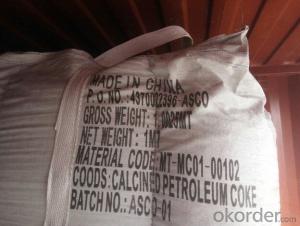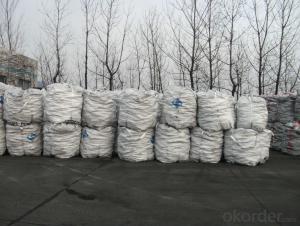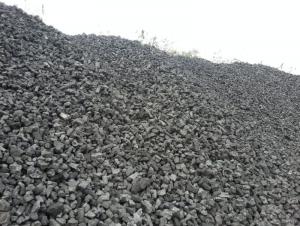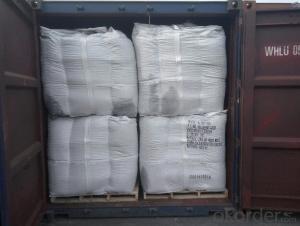Foundry Coke size 80-150MM for Steel Plant
- Loading Port:
- Dalian
- Payment Terms:
- TT OR LC
- Min Order Qty:
- 21.6
- Supply Capability:
- 1016 m.t./month
OKorder Service Pledge
OKorder Financial Service
You Might Also Like
Brief Introduction
Foundry Coke is the main fuel of melting iron in the oven. It can melt the materials in the over, make the iron reach great heat, and keep good air permeability by sustain stock column. Thus, the foundry coke should have the characteristics of big block, low reactivity, small porocity, enough anti-crush strengh, low ash and low sulphur.
The coke handled by our cooperation is made from superior coking coal of Shanxi province. Provided with the advantages of low ash, low sulphur and high carbon. Our coke is well sold in European, American, Japanese and South-east Asian markets. Our owned Coke plant are located in Shanxi Province and supplying of you many kinds of coke.
we supply Foundry Coke long-term, its characteristic is best strength, low sulfur and phosphorus,thermal stability.
Specifications:
ASH % | 8% max | 10% max | 12% max |
V.M.% MAX | 1.5% max | 1.5% max | 2% max |
SULFUR % | 0.65% max | 0.65% max | 0.7% max |
MOISTURE | 5% max | 5% max | 5% max |
Size | 80mm-120mm,80-150,100-150mm, or as request | ||
Features
1. Our quality is always quite good and stable which is producing and packing according to customers' requirements.
2. Putting Client profile into first, achieved mutual benefit.
3. Good partner on business. It's a good and wise choice for customers' to purchase from us. It's our great honor to cooperate with you. It is more -widely used around the world
4. We can supply documents as follows:
- bill of loading,
-Invoice,
-Packing List
-Insurance
-standard inspection pictures of the container as specified by INSPECTORATE
-or more requested by buyer.
Pictures

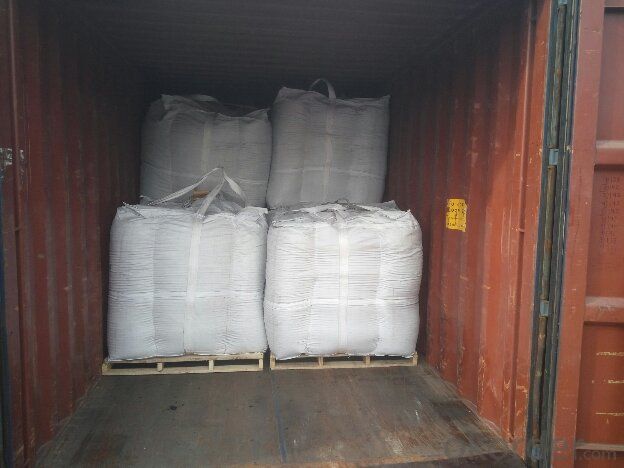
FAQ
1. What is the packing?
In 25kg bag/ In jumbo bags without pallet/ Two jumbo bags with one pallet/ or as customers’ request
2. What is the production capacity?
10 thousand tons per month
3 What is payment term?
Irrevocable LC at sight/ 20% down payment by T/T and 80% against BL copy byT/T/ or to be discussed
4 What is the service?
We will send sample to the third party(CIQ, CCIC, SGS,BV or to be discussed) for checking, and present the test certificate and loading repot of shipment.
- Q: What are the impacts of carbon emissions on the stability of rainforests?
- Carbon emissions have significant impacts on the stability of rainforests, leading to detrimental consequences for both the local ecosystems and the global climate. One of the most notable impacts is the direct contribution to climate change, as carbon dioxide (CO2) is a major greenhouse gas responsible for trapping heat in the atmosphere. This enhanced greenhouse effect leads to rising global temperatures, which in turn negatively affect rainforests. As temperatures increase, rainforests face several challenges. Firstly, higher temperatures can increase the frequency and intensity of droughts, making it difficult for rainforests to maintain their moisture levels. This can lead to decreased water availability for plants and animals, causing stress, reduced growth, and increased vulnerability to diseases and pests. Additionally, droughts can also increase the risk of wildfires, which can devastate large areas of rainforest and further disrupt the delicate ecosystem. Another significant impact of carbon emissions is the alteration of rainfall patterns. Climate change can disrupt the regular rainfall cycles in rainforest regions, leading to either more intense rainfall events or prolonged dry spells. These changes in precipitation patterns can disrupt the natural balance within rainforests, affecting the growth and reproduction cycles of plants and animals. For instance, certain tree species may struggle to reproduce or regenerate if their seeds require specific conditions that are no longer met due to altered rainfall patterns. Furthermore, carbon emissions contribute to increased atmospheric concentrations of CO2, which can directly affect the physiological processes of plants. While some studies suggest that higher CO2 levels can initially enhance plant growth through increased photosynthesis, the long-term effects are more complex. Elevated CO2 can alter the nutrient balance within rainforest ecosystems and may favor certain plant species over others, leading to shifts in species composition and potentially reducing overall biodiversity. Lastly, the impacts of carbon emissions on rainforests extend beyond the local ecosystem. Rainforests are crucial carbon sinks, absorbing a significant amount of the world's CO2 emissions. However, as rainforests face increased stress from climate change, their ability to absorb and store carbon may diminish. This creates a dangerous feedback loop, as reduced carbon storage in rainforests leads to even higher atmospheric CO2 levels, further exacerbating climate change. In conclusion, carbon emissions have profound impacts on the stability of rainforests. From contributing to climate change and altering rainfall patterns to affecting plant physiology and reducing carbon storage capacity, the consequences are far-reaching and detrimental. Protecting rainforests and reducing carbon emissions are essential steps in preserving the stability and biodiversity of these vital ecosystems.
- Q: What is the role of carbon in the formation of fossil fuels?
- The role of carbon in the formation of fossil fuels is crucial. Fossil fuels, such as coal, oil, and natural gas, are formed from the remains of ancient plants and organisms that lived millions of years ago. These organisms were primarily made up of carbon-based compounds. Over time, the organic matter accumulated and was buried under layers of sediment, subjected to intense heat and pressure. This process, known as carbonization, caused the carbon within the organic matter to undergo chemical changes, transforming it into fossil fuels. Therefore, carbon is the key element involved in the formation of fossil fuels.
- Q: How is carbon used in the production of filters?
- Carbon is used in the production of filters due to its highly porous nature and ability to adsorb impurities. It acts as a powerful adsorbent, attracting and trapping contaminants such as chemicals, odors, and particles from air or water. This makes carbon an excellent material for removing impurities and improving the quality of filtered products.
- Q: We need to make a poster... Of the 27 essential elements of the human body, I am in charge of carbon! I haven't found it for a long time! Who can help me? Urgent!!!!!!Can you find something very specific? Thank you
- It can be said that without carbon, there would be no life. Carbon is Dongliangzhicai the world of life.
- Q: What are carbon sinks?
- Carbon sinks, whether natural or artificial, have the important role of absorbing and storing carbon dioxide from the atmosphere, thereby lessening the concentration of greenhouse gases and mitigating climate change. These carbon sinks exist in various forms, such as forests, oceans, wetlands, and soil. Among these, forests are the largest and most widely recognized carbon sinks. Through photosynthesis, trees take in carbon dioxide and convert it to oxygen, storing the carbon within their trunks, branches, and roots. Oceans also serve as significant carbon sinks, absorbing about a quarter of the carbon dioxide emitted by human activities. Algae, phytoplankton, and other marine organisms carry out photosynthesis and convert carbon into biomass. Wetlands, including marshes and swamps, are another crucial carbon sink. They store vast amounts of carbon within their vegetation and soil, preventing its release into the atmosphere. Additionally, soil acts as a carbon sink by absorbing and storing carbon through the decomposition of organic matter and the activities of microorganisms. To further combat climate change, artificial carbon sinks like carbon capture and storage (CCS) technologies are being developed. CCS involves capturing carbon dioxide emissions from power plants and industrial facilities and either storing them underground or repurposing them for other uses. Although these technologies are still in their early stages, they hold the potential to significantly reduce carbon emissions and contribute to climate stabilization. Overall, carbon sinks are vital for maintaining a balanced level of carbon dioxide in the atmosphere and preventing its accumulation, which would contribute to global warming. It is crucial to preserve and restore natural carbon sinks, such as forests and wetlands, in order to mitigate climate change. Additionally, the development and implementation of artificial carbon sinks can further aid in reducing greenhouse gas emissions.
- Q: How can individuals reduce their carbon footprint?
- There are several actions individuals can take to reduce their carbon footprint and contribute to a more sustainable future. Here are some effective ways to achieve this: 1. Reduce energy consumption: Conserving energy is crucial in reducing carbon emissions. Switch to energy-efficient appliances, turn off lights when not in use, unplug electronics when not in use, and use natural lighting whenever possible. Additionally, adjusting thermostats to energy-saving temperatures and using programmable thermostats can significantly reduce energy consumption. 2. Use renewable energy sources: Transitioning to renewable energy sources, such as solar or wind power, can greatly reduce carbon emissions. Install solar panels on rooftops, or consider purchasing green energy from utility companies that offer renewable options. 3. Reduce water usage: Conserving water indirectly helps reduce energy consumption and carbon emissions. Fix leaky faucets, take shorter showers, install water-saving fixtures, and collect rainwater for outdoor use. Also, consider using drought-resistant landscaping to reduce water usage for gardening. 4. Consume consciously: Make sustainable choices when purchasing products. Opt for durable and long-lasting items, repair and reuse instead of replacing, and prioritize products made from recycled or sustainable materials. Additionally, support local and sustainable businesses that prioritize eco-friendly practices. 5. Minimize transportation emissions: Reduce reliance on private vehicles by opting for public transportation, carpooling, biking, or walking whenever possible. If owning a car is necessary, choose electric or hybrid vehicles. Regular maintenance, proper tire inflation, and avoiding unnecessary idling all contribute to reducing transportation emissions. 6. Adopt a plant-based diet: The food industry has a significant carbon footprint, especially due to livestock production. Reducing meat consumption or adopting a plant-based diet can greatly reduce carbon emissions and also offer health benefits. If going completely plant-based is not feasible, try incorporating more vegetarian or vegan meals into your diet. 7. Reduce waste generation: Waste contributes to greenhouse gas emissions, so reducing waste is essential. Opt for products with minimal packaging, recycle diligently, compost organic waste, and avoid single-use plastics. Reduce food waste by planning meals, buying only what is needed, and properly storing leftovers. 8. Support environmental initiatives and organizations: Engage with local and global organizations working towards environmental conservation. Participate in community clean-ups, support reforestation efforts, and advocate for sustainable practices in your workplace and community. By implementing these strategies in our daily lives, individuals can make a significant impact in reducing their carbon footprint and help combat climate change. It is important to remember that every small action matters, and collectively, we can create a sustainable future for generations to come.
- Q: What is methane?
- Methane is a colorless and odorless gas that is the primary component of natural gas. It is formed from the decay of organic matter and is a potent greenhouse gas.
- Q: What is carbon black filler?
- Carbon black filler, a commonly utilized additive in the production of rubber and plastic products, is derived from the incomplete combustion of hydrocarbons, such as oil or natural gas. It takes the form of a fine, powdery substance and is primarily composed of elemental carbon, with trace amounts of hydrogen, oxygen, and sulfur. The primary objective of incorporating carbon black filler is to enhance the physical characteristics of rubber and plastic materials. Its addition improves the strength, durability, and wear resistance of the final product. Furthermore, carbon black filler increases the material's stiffness and hardness, making it suitable for various applications. Beyond its mechanical properties, carbon black filler offers additional advantages. It acts as a reinforcing agent, augmenting the tensile strength and tear resistance of rubber compounds. Additionally, it heightens the material's electrical conductivity, proving valuable in scenarios where static electricity dissipation is necessary. Moreover, carbon black filler safeguards the material against the detrimental effects of UV radiation and ozone. It serves as a UV stabilizer and antioxidant, preventing degradation and extending the product's lifespan. Furthermore, carbon black filler enhances the thermal conductivity of rubber and plastic materials, facilitating heat dissipation. Overall, carbon black filler is a versatile and extensively employed additive in the manufacturing industry. Its distinctive attributes render it an indispensable component in the production of various rubber and plastic products, including tires, conveyor belts, hoses, gaskets, among others.
- Q: What role does carbon play in photosynthesis?
- The role of carbon in photosynthesis is crucial because it serves as the primary element utilized by plants to generate organic compounds. In the process of photosynthesis, plants absorb carbon dioxide from the atmosphere and employ it to synthesize glucose, a simple sugar that acts as a foundational component for more intricate carbohydrates like starch and cellulose. This entire process takes place within the chloroplasts of plant cells, specifically in the stroma of the chloroplast. It is in this location that the enzyme RuBisCO facilitates the fixation of carbon dioxide into an organic molecule called PGA (phosphoglycerate). By means of a series of reactions referred to as the Calvin cycle, PGA is transformed into glucose, which can be either stored as energy or utilized for growth and reproduction. To sum up, carbon is indispensable to photosynthesis since it supplies the necessary raw material for plants to self-generate their own sustenance and maintain life.
- Q: What is carbon nanotube?
- Carbon nanotubes are cylindrical structures made up of carbon atoms arranged in a unique hexagonal lattice pattern. They are incredibly small, with diameters on the nanometer scale (about 1 billionth of a meter) and lengths that can range from a few nanometers to several centimeters. Carbon nanotubes possess remarkable properties that make them highly attractive for a wide range of applications. They are incredibly strong, with tensile strength that exceeds that of any other known material, making them ideal for use in structural composites. They also have excellent electrical conductivity, thermal conductivity, and are chemically stable, which makes them useful in fields such as electronics, energy storage, and catalysis. There are two main types of carbon nanotubes: single-walled nanotubes (SWNTs) and multi-walled nanotubes (MWNTs). Single-walled nanotubes consist of a single layer of carbon atoms rolled into a tube, while multi-walled nanotubes consist of multiple concentric layers of carbon atoms. The arrangement of carbon atoms and the diameter of the tube determine the properties of the nanotube. Carbon nanotubes have the potential to revolutionize various industries due to their unique properties. They are being explored for applications in electronics, where they can be used as high-performance transistors, interconnects, and sensors. They also hold promise in the field of energy storage, as they can be used in batteries and supercapacitors that have higher energy densities and faster charging rates. Additionally, their high surface area and unique chemical properties make them suitable for catalytic applications, such as water purification and chemical synthesis. Despite their immense potential, there are still challenges to overcome in the large-scale production and commercialization of carbon nanotubes. However, ongoing research and development efforts continue to push the boundaries of their applications, making carbon nanotubes an exciting field of study with significant future possibilities.
Send your message to us
Foundry Coke size 80-150MM for Steel Plant
- Loading Port:
- Dalian
- Payment Terms:
- TT OR LC
- Min Order Qty:
- 21.6
- Supply Capability:
- 1016 m.t./month
OKorder Service Pledge
OKorder Financial Service
Similar products
Hot products
Hot Searches
